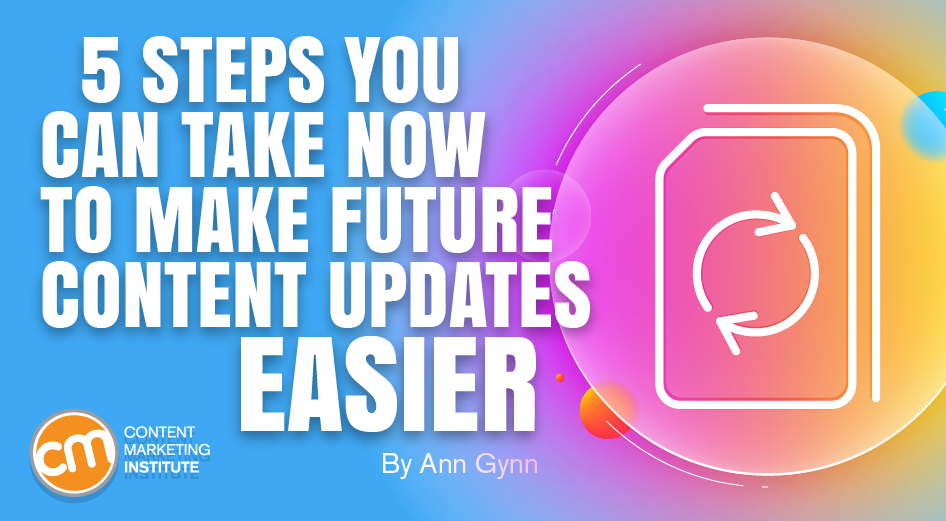MARKETING
5 Steps You Can Take Now To Make Future Content Updates Easier

You’ve probably read lots of advice on how to refresh, reuse, and revise old content. The first step is almost always the same: Conduct a content audit.
Frankly, some marketers see that advice and move on. After all, a content audit takes a lot of time – from figuring out how to do it to the actual execution.
But what if refresh, reuse, and revise didn’t require a full-fledged content audit. What if you already knew what to do? You probably would be more likely to do it.
So how do you get to that point? The solution is rooted in advice on forming good preparation habits.
Study this list of tips from Apartment Therapy on how to make leaving the house on time easier, for example:
- Set a designated space for keys.
- Pack your work bag the night before.
- Organize your closet by what you’re wearing.
- Make your breakfast ahead of time
- Set out your morning products at night.
Can you detect the theme?
Each tip (from designating a space for keys to organizing the closet by what you wear) requires looking ahead and preparing today for what you’ll need in the future.
You can do the same with your content. So instead of looking backward with a content audit, form new forward-looking habits that will make your content operations more efficient down the road.
You won’t need a backward-looking #content audit if you adopt forward-looking content habits today, says @AnnGynn via @CMIContent @semrush. #ContentMarketing Click To Tweet
HANDPICKED RELATED CONTENT:
1. Tag dated content
Timely references in content often offer good context – until they’re no longer timely. Then, they become a negative, indicating to your audience that the piece is outdated (even if all the other information is still valid) and your brand didn’t notice (or worse, didn’t care.)
When you write, record, or edit content that includes moment-in-time surveys, studies, etc., add an internal tag, such as “dated” or another trigger word. You could do this on your content planning calendar or your content management system. If you wanted to get even more granular, you could list the specific, timely mentions on your tracker so future reviewers can go directly to that line.
Then, you can search for the tag, go through the timely mentions, and update as appropriate. If you can’t find a current reference to replace the outdated one, rework the rest of the content so it’s still valid.
TIP: Establish a regular frequency (at least annually) to revisit content you’ve tagged for updating.
Tag #content with time-specific references on your calendar or in your CMS. Review those pieces annually (at least) to make any needed updates, says @AnnGynn via @CMIContent @semrush. Click To Tweet
2. Use the actual year
This tip doesn’t require any additional work after the piece is published. Instead of saying “this year” or “last year,” specify the actual year. That way, audiences who consume the content in the future will know which year it refers to.
The same advice goes for “yesterday,” “today,” “this week,” “last week,” etc.
One caveat: You can skip this tip if you craft content designed as a news vehicle, where the current-focused language is appropriate. It won’t matter if readers see the content as not timely down the road because it should be outdated by then.
Avoid phrases like this year, last month, where possible. Write (or say) the actual year or month, so you won’t have to go back and update those references later, says @AnnGynn via @CMIContent @semrush. Click To Tweet
ADVERTISEMENT
The State of Content Marketing 2022 Global Report
500K articles analyzed. 1,500 marketers surveyed. 9 experts interviewed. Download the biggest industry report by Semrush and explore thousands of data points to build a better content marketing strategy.
3. Craft smarter calls to action
The most powerful calls to action often have an “act-now” message designed to motivate people to take action right away. However, time-centered CTAs (i.e., for an upcoming event) or campaign-related CTAs (i.e., a new e-book release) usually expire long before the content does.
If your time-centered event repeats (every year, for example), craft a CTA that can work in any cycle.
For example, let’s say you’re creating a registration CTA for your company’s annual summer event. Create a forward-thinking CTA that won’t become out of date after the event, such as, “Register now for the best rates for this summer’s Big Brand Event.”
TIP: Work with your events team to ensure the website address remains the same year after year.
If you must create a time-specific CTA, follow the same advice for tagging content – track which CTAs need to be updated and when. Then, add those updates to your scheduling calendar.
4. Ask your sources for help
Content often incorporates the names, titles, and employers of quoted sources. But we all know any of those three identifiers can change. Of course, tracking every source in your content isn’t an easy task. Instead, use these two tricks – one for external and one for internal sources.
External sources: Ask sources for their LinkedIn handle. Include that link when they’re referenced in your content. Then, even if they move jobs, the audience can click and find out their current role. You also can ask sources to send updates if they change their name, title, and employer. (I realize this is less likely to happen, but it’s worth a shot.)
Internal sources: It’s easier to track sources within your company’s ranks. More than likely, these people get quoted or published more than once. Set up a way to pull the content they created or contributed to. (Think byline links for authors that showcase all pieces of content they contributed.)
5. Set up the right shot
People change more than their titles and names. They change their appearance, too. Whether they now wear glasses, have different hair color, or are five years older, they may not look like their headshot forever. So they get a new headshot, but they never share it with you.
To keep headshot images current, use a photo-imaging API tool like Gravatar. Ask people to set up their own accounts and share the associated email address with you. If you’ve integrated the Gravatar tool into your site, any time someone changes their headshot, it automatically updates on your site, too.
Move forward from the beginning of your content process
If you dread hearing the phrase “content audit” as a solution to refresh, reuse, and revise your content, take preventative measures now. A forward-thinking process will let you quickly find content to update or eliminate manual involvement altogether.
HANDPICKED RELATED CONTENT:
All tools included in the article are suggested by author. Feel free to include additional tools in the comments (from your company or ones that you have used).
Cover image by Joseph Kalinowski/Content Marketing Institute
!function(f,b,e,v,n,t,s)
{if(f.fbq)return;n=f.fbq=function(){n.callMethod?
n.callMethod.apply(n,arguments):n.queue.push(arguments)};
if(!f._fbq)f._fbq=n;n.push=n;n.loaded=!0;n.version=’2.0′;
n.queue=[];t=b.createElement(e);t.async=!0;
t.src=v;s=b.getElementsByTagName(e)[0];
s.parentNode.insertBefore(t,s)}(window, document,’script’,
‘https://connect.facebook.net/en_US/fbevents.js’);
fbq(‘init’, ‘1432232210459613’);
fbq(‘track’, ‘PageView’);













You must be logged in to post a comment Login